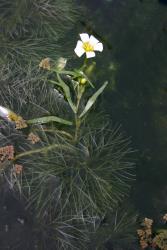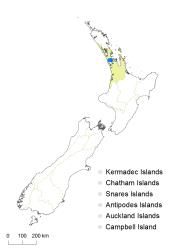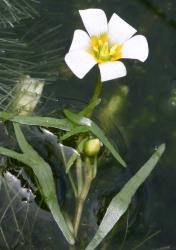Perennial, aquatic herb, repent rhizomes/stems tenuously attached to the substrate. Roots adventitious. Submerged vegetative parts thinly mucilaginous. Stems flexuose and fragile, terete, 1–5 m × 1–3 mm, branching and ascendant, with prominent nodes and internodes, green or reddish brown, with longitudinal striations; glabrescent with short white and longer red-brown mucilage-producing trichomes. Submersed leaves opposite and decussate, rarely a whorl of 3 (not NZ); lamina 20–50 × 25–70 mm, fan-shaped, dividing dichotomously and trichotomously into many fine segments; lamina segments 0.8–1.5 mm wide, linear or slightly spathulate, membraneous, sparsely covered in minute trichomes; margin entire, minutely prickle-toothed; apex obtuse; petiole 2–30 mm long. Floating leaves (inconspicuous and present only with flowers), alternate, simple; lamina 12–20 × 1–3 mm, linear to narrow-elliptic, or trullate, tapering towards the ends, sometimes sagittate, coriaceous, glabrescent; margin entire; apex sub-acute to obtuse, peltately attached to petioles; petiole 7–20 mm long, terete. Flowers 6–20 mm in diameter, 5–12 mm long, solitary; 2 whorls of 3 petaloid tepals, oblong or obovate-elliptic with obtuse or emarginate apices, white or pale yellow, darker yellow towards the centre, sometimes margins purple-tinged; inner tepals with nectaries on 2 yellow auriculate basal appendages. Stamens 3 or 6; anthers approximately 1.5 mm long; pollination syndrome entomophilous. Carpels (2)–3–(4), ventricose, divergent at maturity, covered with red-brown trichomes; 2–3 ovules per carpel. Fruit indehiscent, 4–7 mm long, yellowish (not seen in NZ). Seeds 1–3, 1.5–3.0 × 1–1.5 mm, ovoid to ellipsoid, surface tuberculate in longitudinal rows. Dispersal hydrochory.
The flowers are emergent above the water surface and in the axil of a linear, peltate leaf (sometimes arrow-shaped). The three inner tepals of the flower are distinctive, with two bright yellow nectaries on ear-like appendages at the base. The leaves are in opposite pairs, which distinguishes Cabomba caroliniana from other aquatic plants with finely divided leaves in New Zealand.
Following the detection of the Paremuka storm retention ponds site, C. caroliniana was declared an unwanted organism in 2016 under the Biosecurity Act 1993. This prevents the sale and distribution of this species in the aquarium trade. Prior to this declaration, C. caroliniana was one of the most popular aquarium plants used by aquarists and had been traded for more than 40 years (Champion & Clayton 2001). Another is Cabomba furcata (red cabomba) and although not recorded naturalised in New Zealand is present in cultivation (Champion & Clayton 2001). In contrast to Cabomba caroliniana it has whorled submerged leaves and violet flowers.
North Island: Auckland – Auckland City, Point Chevalier, small spring feeding into Meola Creek, Aug 2009 (failed to persist – absent in 2016; PDC pers. obs.), Henderson, Paremuka Lakes/storm water ponds (all three lakes, Feb 2016).
Occurs naturally in USA (Alabama, Arkansas, California, Connecticut, District of Columbia, Delaware, Florida, Georgia, Illinois, Indiana, Kansas, Kentucky, Louisiana, Massachusetts, Maryland, Michigan, Missouri, Mississippi, North Carolina, New Hampshire, New Jersey, New York, Ohio, Oklahoma, Oregon, Pennsylvania, Rhode Island, South Carolina, Tennessee, Texas, Virginia, Washington State), Canada (Ontario), WC-Brazil (Mato Grosso), SE-Brazil (Rio Grande do Sul, Sao Paulo), Argentina (Buenos Aires, Cordoba, Corrientes, Entre Rios, Rio Negro, Santa Fe), Paraguay (Alto Paraguay, Central, Paraguari, Pres. Hayes), Uruguay (Soriano), Bolivia (Cochabamba).
Naturalised in Colombia, Australia, Sri Lanka, India, Austria, Netherlands, S- China, Japan, Korea, peninsular Malaysia, Vietnam, New Guinea (GBIF https://www.gbif.org/species/2882443), north-eastern and western USA (McCracken et al. 2013). Three phenotypes are recognised in the USA (Bultemeier et al. 2009), with most of the northern USA and Canadian populations dissimilar from native C. caroliniana in the south-eastern USA.
As an escapee of the aquarium trade, it is well established outside its native range of south-eastern USA and South America. Most likely the New Zealand incursions are from inappropriately discarded aquarium waste.
Sub-tropical to temperate, growing in stagnant or gently flowing waters of ponds, ditches, drains, lakes and streams.
CHR 305927, P.J. de Lange 7940, 23 Aug 2009, Auckland City, Point Chevalier, small spring feeding into Meola Creek.
Flowering: late spring–early autumn (Schneider & Jeter 1982).
Dispersal by seed or vegetative detachment from readily fragmented stems or a leaf and node (Bickel 2015, 2017; Ørgaard 1991). Caging experiments indicate that apomixis and autogamy do not occur (Schneider & Jeter 1982). After fertilisation the petiole bends and the developing fruit is submerged underwater, maturing then disintegrating and releasing seeds (although fruiting not seen in New Zealand).
2n = c. 96 (Okada & Tamura 1981); 2n = 39, c. 78, c. 104 (Ørgaard 1991); 2n = 34 (Sen & Bhaduri 1971).






